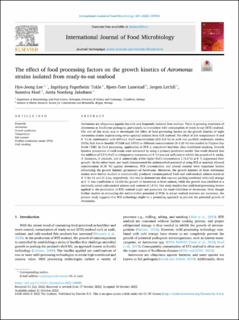| dc.contributor.author | Lee, Hye-Jeong | |
| dc.contributor.author | Tokle, Ingebjørg Fagerheim | |
| dc.contributor.author | Lunestad, Bjørn Tore | |
| dc.contributor.author | Lerfall, Jørgen | |
| dc.contributor.author | Hoel, Sunniva | |
| dc.contributor.author | Jakobsen, Anita Nordeng | |
| dc.date.accessioned | 2022-11-09T12:18:04Z | |
| dc.date.available | 2022-11-09T12:18:04Z | |
| dc.date.created | 2022-11-03T20:55:26Z | |
| dc.date.issued | 2022 | |
| dc.identifier.citation | International journal of food microbiology. 2022, 384 . | en_US |
| dc.identifier.issn | 0168-1605 | |
| dc.identifier.uri | https://hdl.handle.net/11250/3030930 | |
| dc.description.abstract | Aeromonas are ubiquitous aquatic bacteria and frequently isolated from seafood. There is growing awareness of Aeromonas as foodborne pathogens, particularly in connection with consumption of ready-to-eat (RTE) seafood. The aim of this study was to investigate the effect of food processing factors on the growth kinetics of eight Aeromonas strains (representing seven species) isolated from RTE seafood. The effect of low temperature (4 and 8 °C) in combination with different NaCl concentrations (0.5–6.5 %) or with two purified condensate smokes (PCSs; Red Arrow SmokEz VTABB and JJT01) at different concentrations (0–0.26 %) was studied in Trypton Soy Broth (TSB). In food processing, application of PCS is considered healthier than traditional smoking. Growth kinetics parameters of each strain were estimated by using a primary predictive model. Our result showed that the addition of 3.5 % NaCl at refrigeration temperature (4 °C) was not sufficient to inhibit the growth of A. media, A. bestiarum, A. piscicola, and A. salmonicida, while higher NaCl concentration (≥5.0 %) at 8 °C suppressed their growth. On the other hand, our result demonstrated the antimicrobial potential of using PCS at maximal allowed concentration (0.26 %) against Aeromonas. PCS concentration and phenol content were important factors influencing the growth kinetics parameters of Aeromonas. Moreover, the growth kinetics of three Aeromonas strains were further studied in commercially produced vacuum-packed fresh and cold-smoked salmon stored at 4 °C for 14 and 21 days, respectively. Our results demonstrate that vacuum packing combined with cold storage at 4 °C was insufficient to inhibit the growth of Aeromonas in fresh salmon, while the growth was inhibited in a minimally salted cold-smoked salmon (salt content of 1.8 %). Our study implies that mild food processing factors applied in the production of RTE seafood might not guarantee the total inhibition of Aeromonas. Even though further studies on evaluating the antimicrobial potential of PCSs in actual seafood matrixes are necessary, the present study suggests that PCS technology might be a promising approach to prevent the potential growth of Aeromonas. | en_US |
| dc.language.iso | eng | en_US |
| dc.title | The effect of food processing factors on the growth kinetics of Aeromonas strains isolated from ready-to-eat seafood | en_US |
| dc.title.alternative | The effect of food processing factors on the growth kinetics of Aeromonas strains isolated from ready-to-eat seafood | en_US |
| dc.type | Peer reviewed | en_US |
| dc.type | Journal article | en_US |
| dc.description.version | publishedVersion | en_US |
| dc.source.pagenumber | 12 | en_US |
| dc.source.volume | 384 | en_US |
| dc.source.journal | International journal of food microbiology | en_US |
| dc.identifier.doi | 10.1016/j.ijfoodmicro.2022.109985 | |
| dc.identifier.cristin | 2068947 | |
| cristin.ispublished | true | |
| cristin.fulltext | original | |
| cristin.qualitycode | 2 | |
